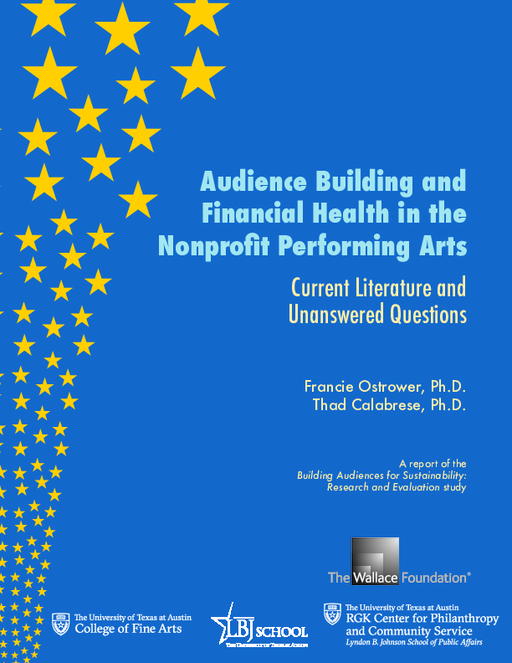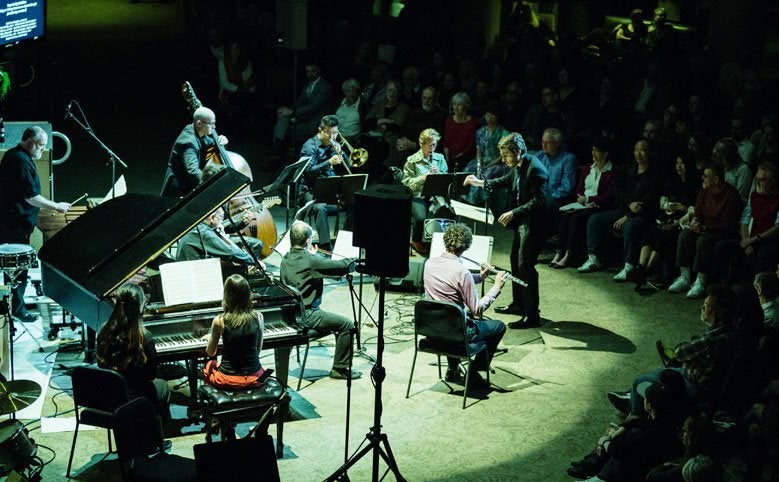Breadcrumb
- Wallace
- Reports
- Audience Building And Financial ...
Audience Building and Financial Health in the Nonprofit Performing Arts
Current Literature and Unanswered Questions

- Author(s)
- Francie Ostrower and Thad Calabrese
- Publisher(s)
- The University of Texas at Austin
Summary
How we did this
The authors used multiple methods to identify literature on audience building. These included searching online publication databases and catalogs, reviewing library shelves under relevant call numbers, and searching Google Scholar.
Nonprofit performing arts organizations today face significant challenges. Even before the pandemic,* national statistics showed stagnant or declining attendance at arts performances. Newspapers reported on financial crises at established organizations.
How should arts organizations respond? While there is consensus in the sector that these problems exist, there is less agreement on how to address them.
In Audience Building and Financial Health in the Nonprofit Performing Arts: Current Literature and Unanswered Questions, authors Francie Ostrower and Thad Calabrese review recent literature on audience building, financial health, and the relationship between the two. They examine what the literature says about attendance and finances in the nonprofit performing arts sector. They consider how organizations are responding to these challenges. And they attempt to understand which approaches have been more successful.
Ostrower and Calabrese find that attendance at multiple arts forms has declined. Fewer people attend performances. Those that do, go less often. Hypotheses on what is driving this decline range from a decline in school-based arts education to outdated operations of arts organizations. The authors find merit in some of these theories, but less in others.
Audience Building Strategies
Existing literature proposes a wide array of audience-building strategies. Yet the results of these efforts don't point to obvious solutions. One prevalent idea is that audiences seek an arts experience, not just a performance. The literature offers some proposed strategies for creating this experience. These include performing in non-traditional venues, creating a more welcoming environment, and using more technology and digital media.
But neither audiences nor arts organizations are all the same. The literature suggests that a "one size fits all" approach to building audiences may not be effective. Rather, different approaches may be better suited to different audiences. These approaches may also serve different goals, requiring some trade-offs. Successful audience building may also demand shifts in both organizational culture and operations.
Financial Health
Ostrower and Calabrese find little literature on the financial health of the arts, and even less on the performing arts. There are no established definitions or measures related to financial health in the nonprofit performing arts. Capitalization, organizational capacity, and sustainability are a few measures used. But little direct application to performing arts organizations exists.
The authors also re-visit Baumol and Bowen’s "cost disease theory.” This theory states that financial problems arise in performing arts organizations because costs increase faster than ticket prices. The resulting gap requires other revenue sources to offset these losses. The authors find that medium-sized organizations are most susceptible to “cost disease.”
Ostrower and Calebrese conclude by linking audience building back to financial health. Audience building as it relates to organizational finances is not well studied. It may build social, not financial returns. As performing arts organizations seek to build audiences, they must understand the real cost of audience building activities.
*Ostrower and Calebrese conducted this literature review prior to the coronavirus pandemic, which shuttered performance venues across the U.S. and the globe. The challenges facing nonprofit performing arts organizations post-covid are even greater.

Arts nonprofits overwhelmingly report that funders are more interested in program expansion than helping support long-term needs such as building reserves or cash flow needs.
Key Takeaways
- The literature surveyed for this report proposes a wide array of audience-building techniques to address declining attendance, but results don’t point to obvious solutions.
- A widespread theme in the literature is that arts audiences increasingly seek an arts experience, not just a performance.
- Different approaches may be better suited to engaging different audiences and serve different goals. Tradeoffs may be needed.
- Audience building is not an isolated endeavor. It may require shifts in culture and operations.
- Baumol and Bowen’s “cost disease”—the theory that financial problems arise in performing arts organizations because costs increase faster than ticket prices—affects medium-sized organizations the most.
Materials & Downloads
What We Don't Know
- To what extent are audience declines a response to what arts organizations are presenting (the art forms), versus how arts organizations present the art or other organizational characteristics?
- Are there particular financial indicators that better predict financial health than others in the performing arts domain?
- How might a performing arts organization in financial trouble turn itself around?
- How can overhead costs not directly linked to performances be understood in light of Baumol and Bowen’s prevailing “cost disease” theory?






